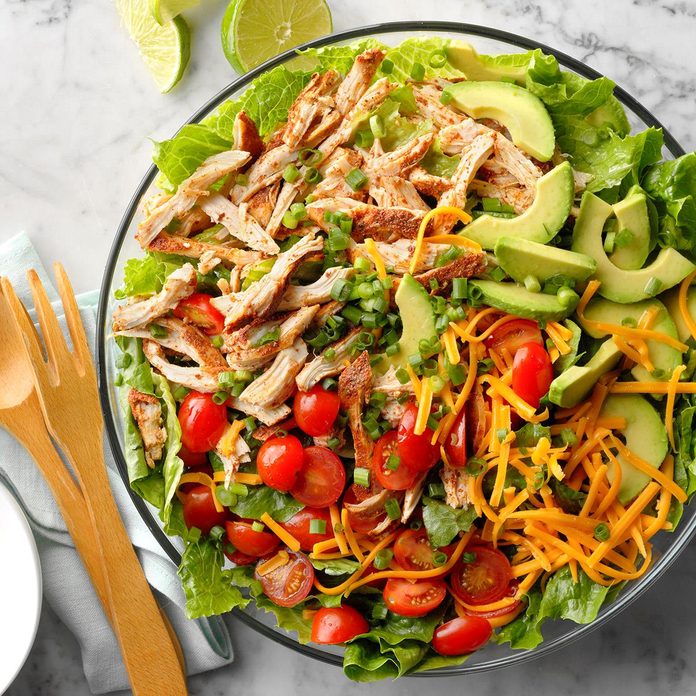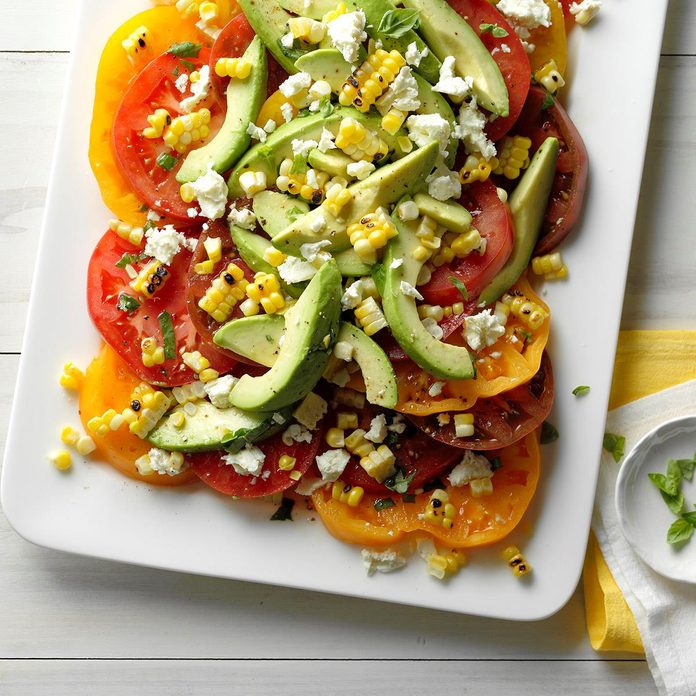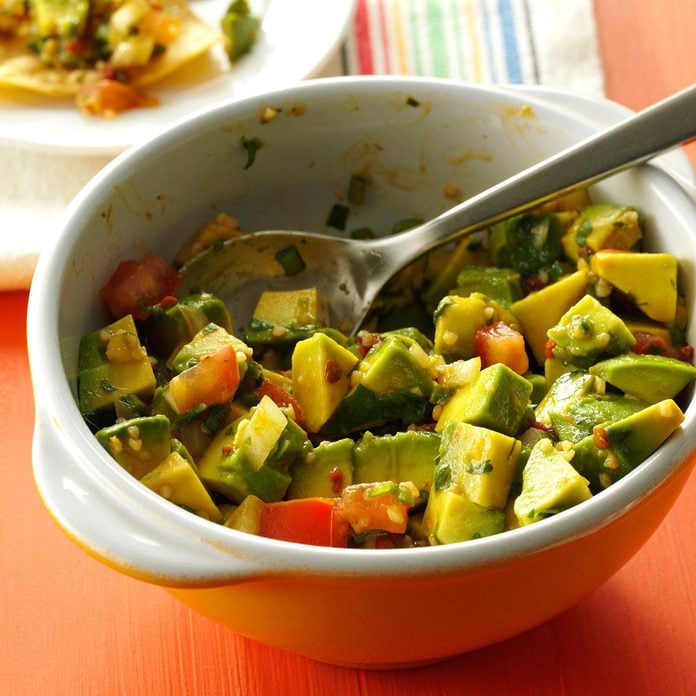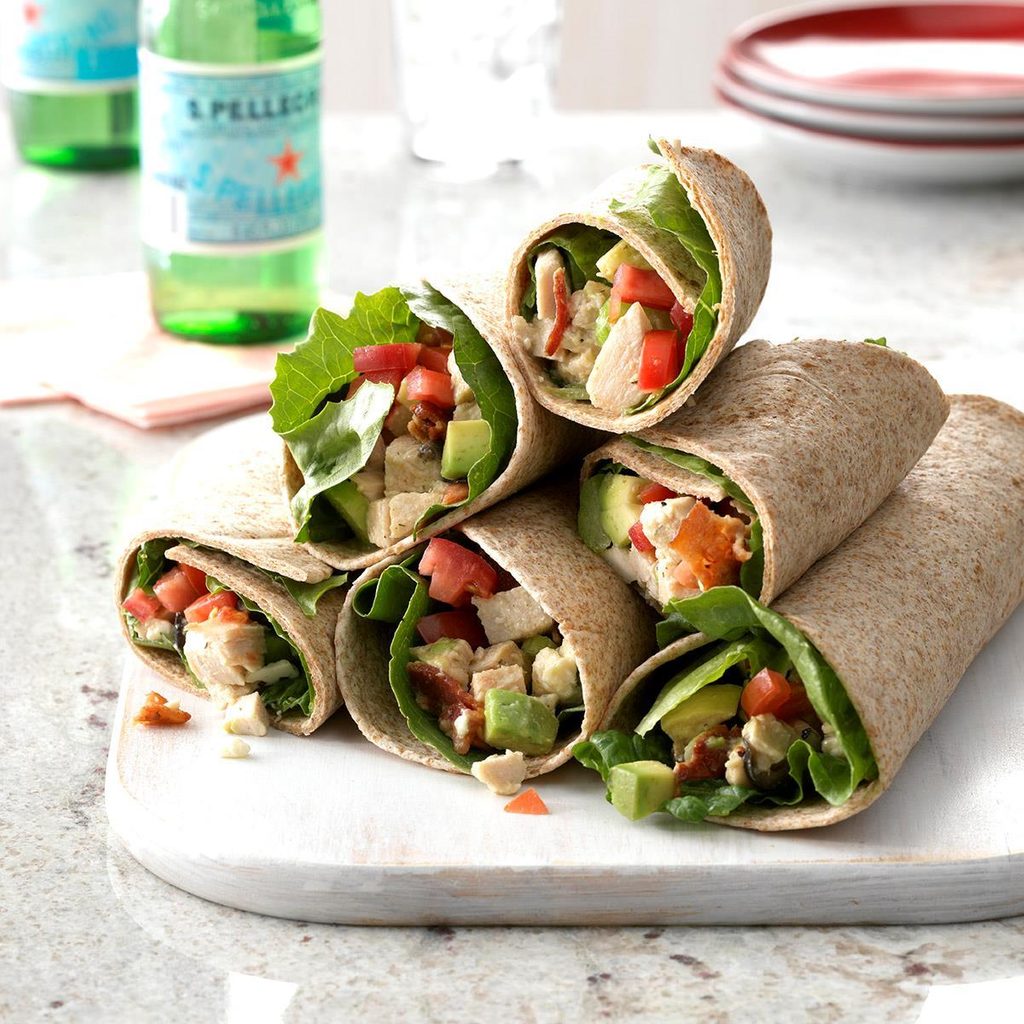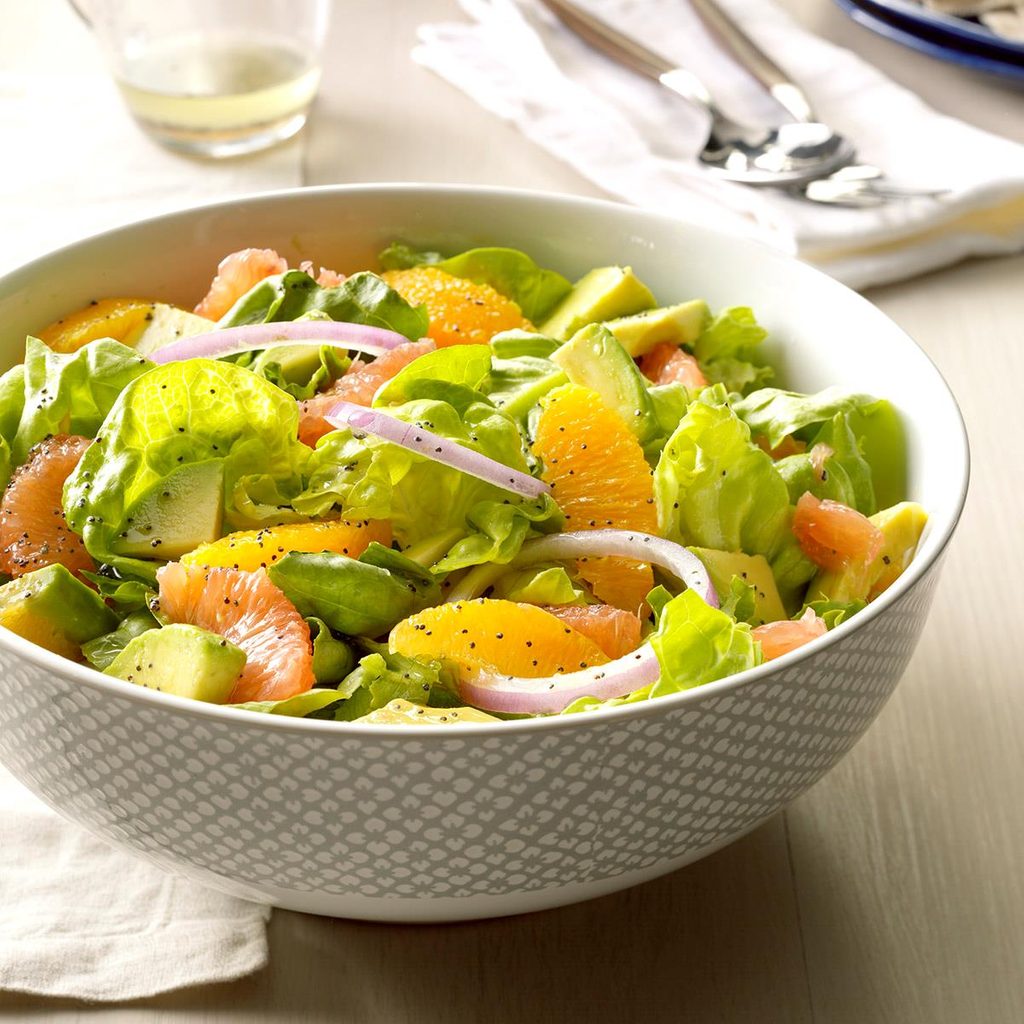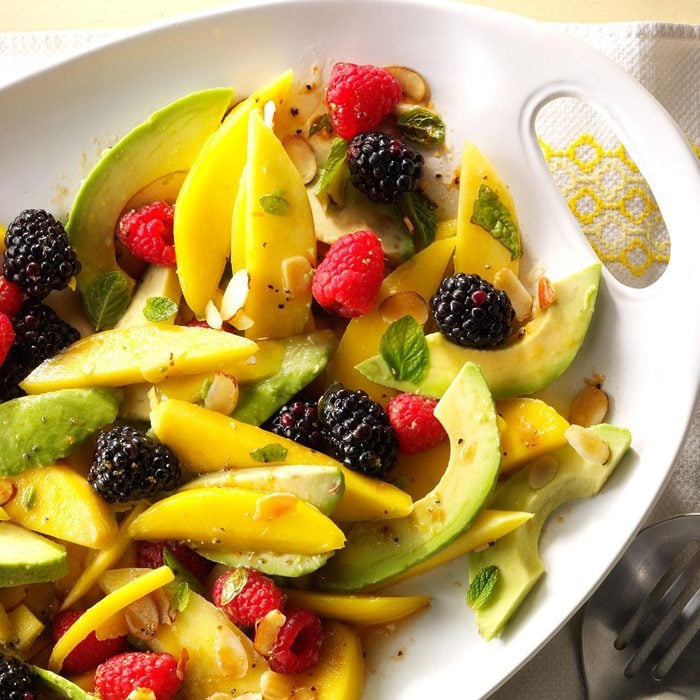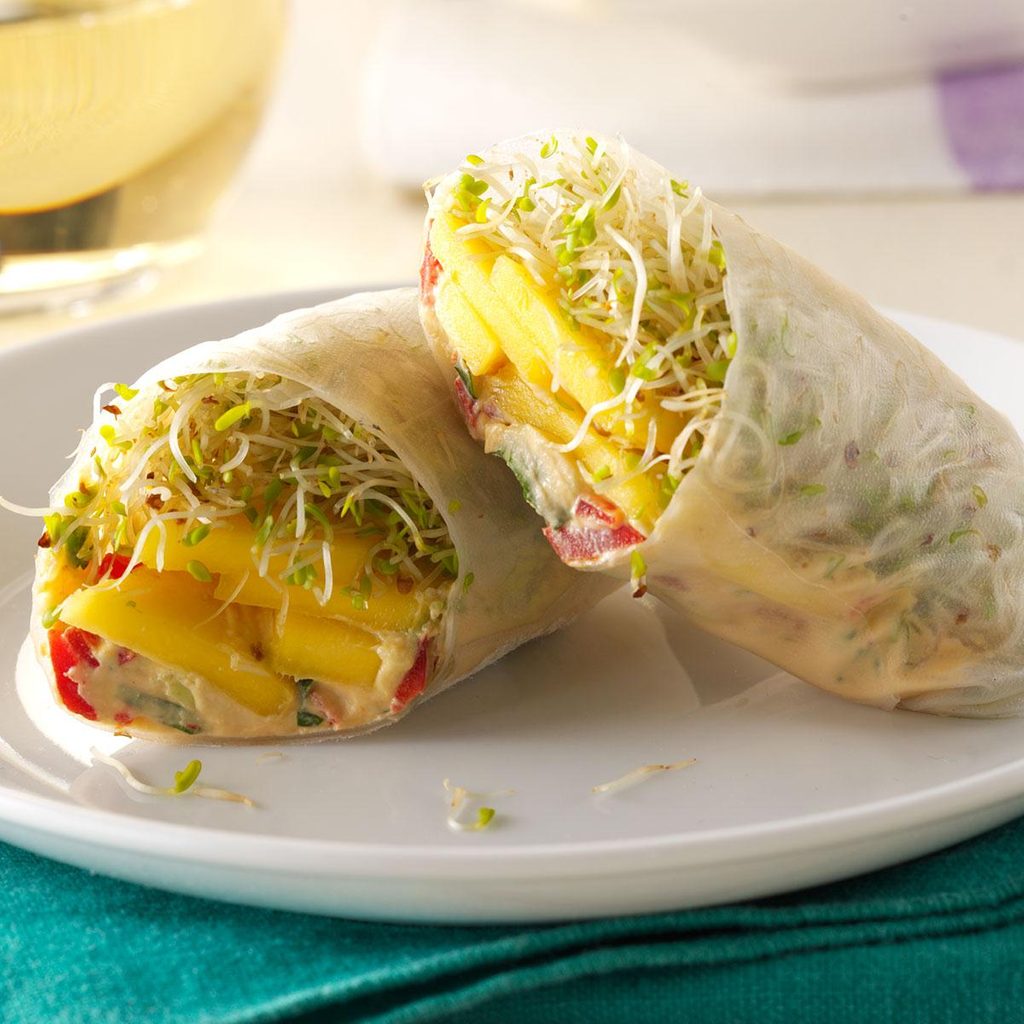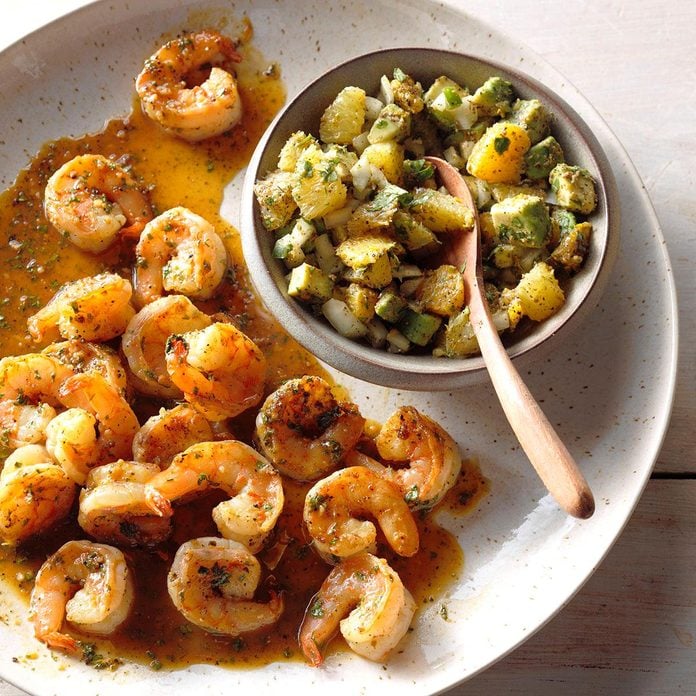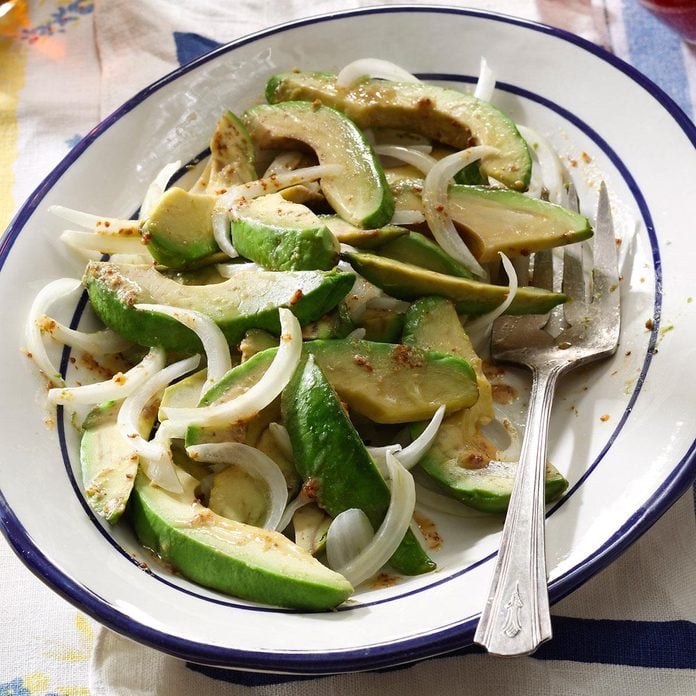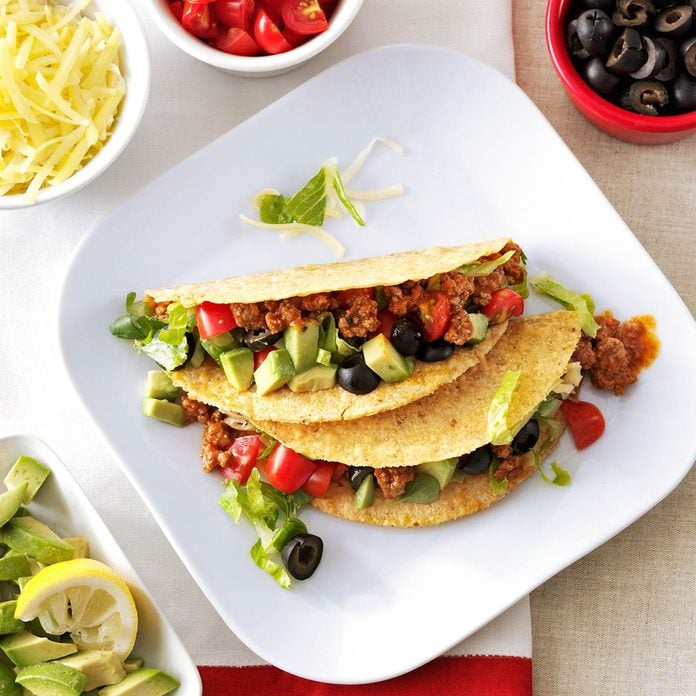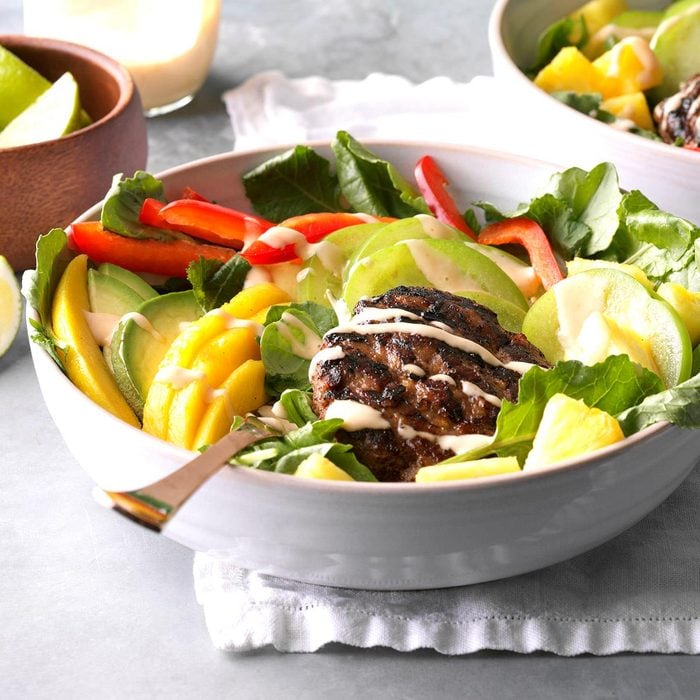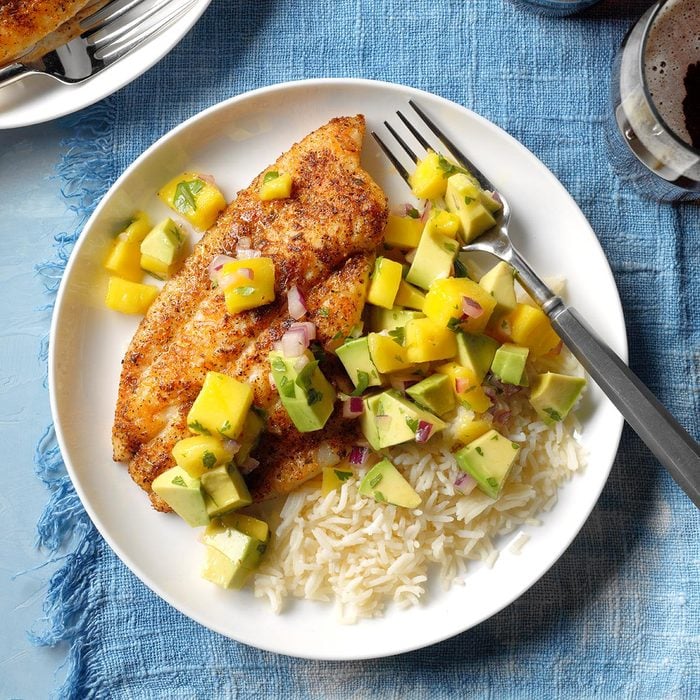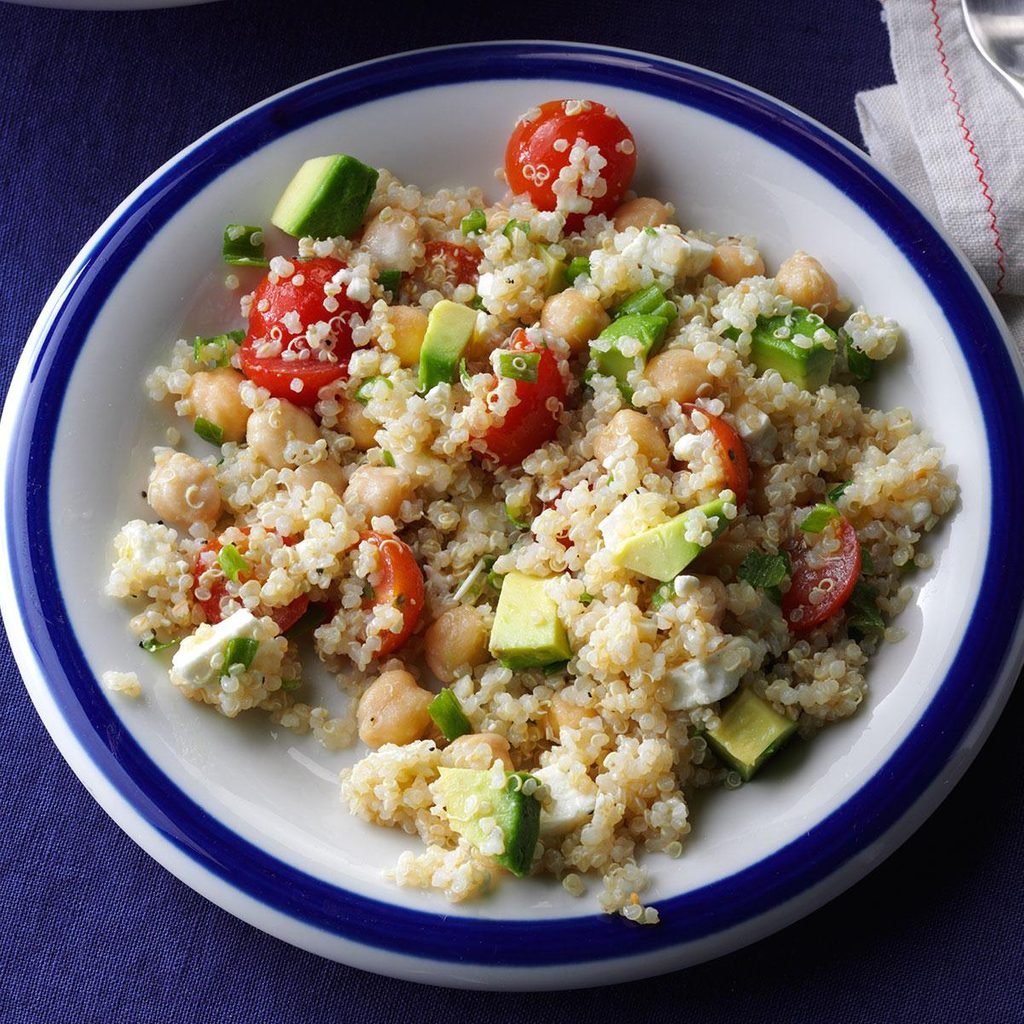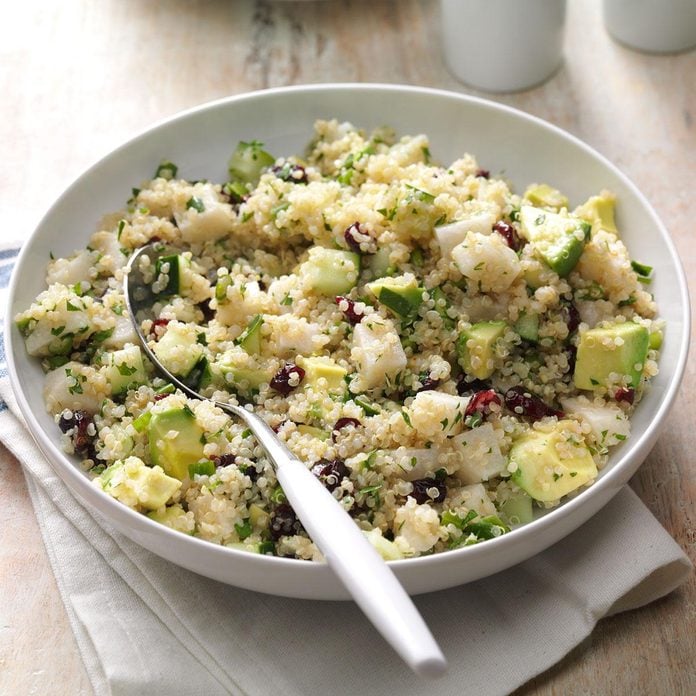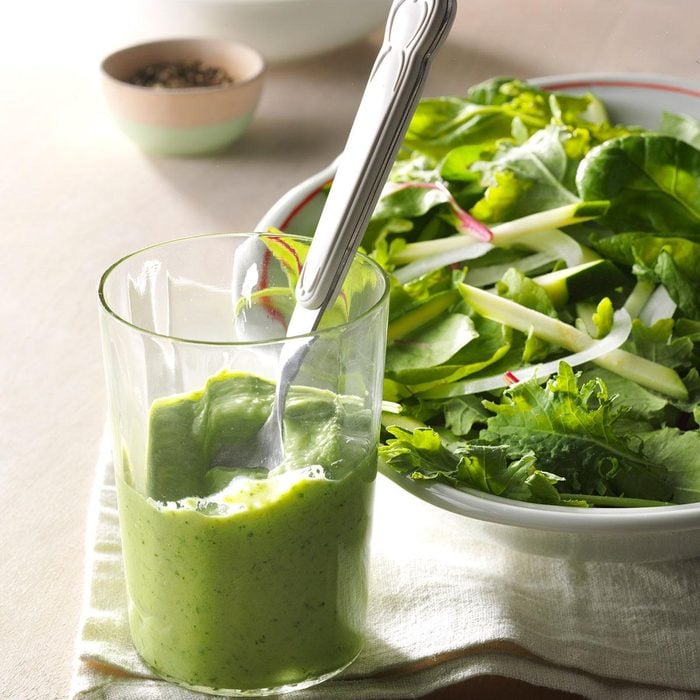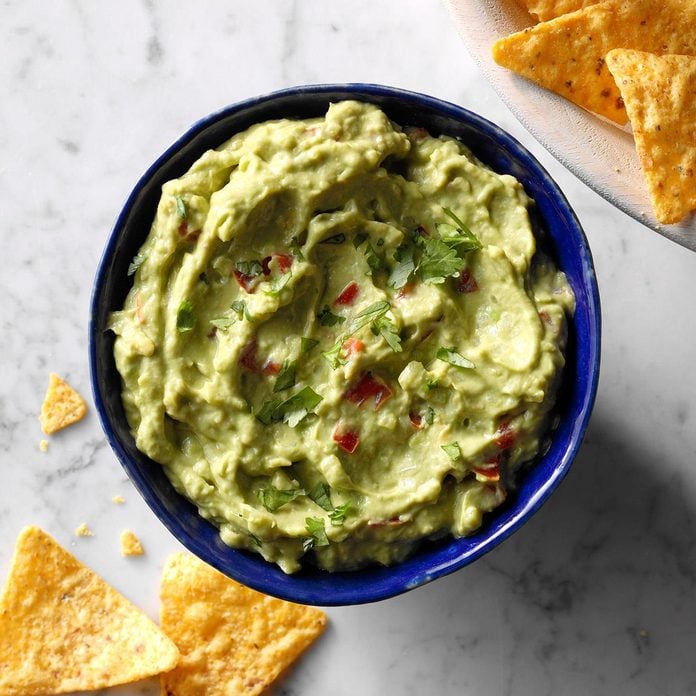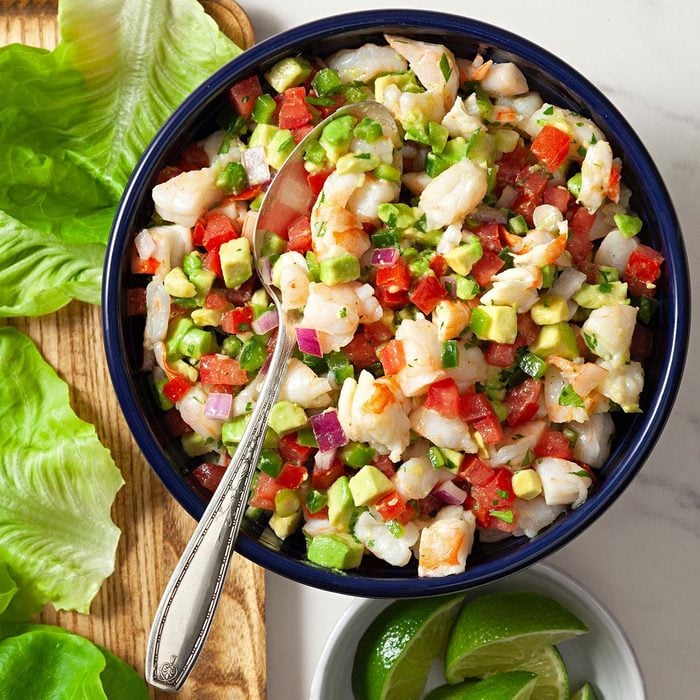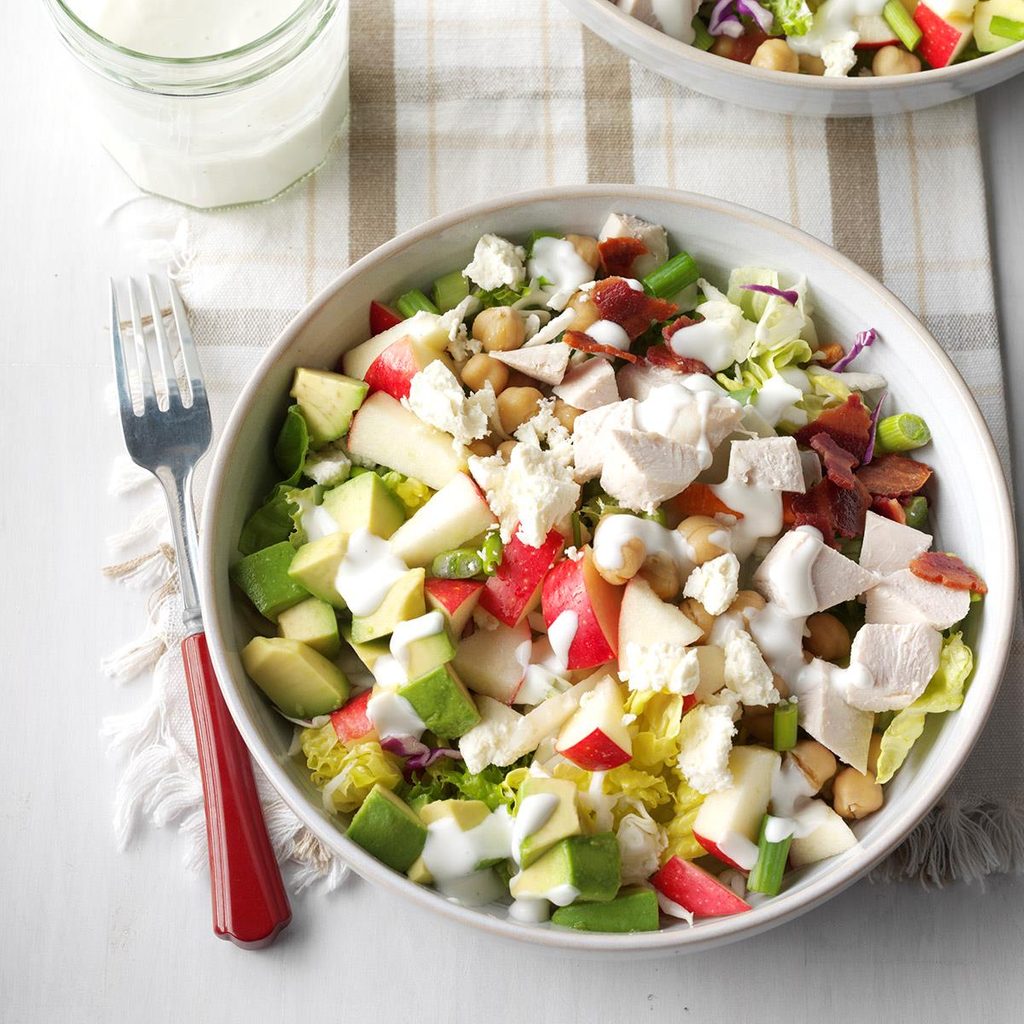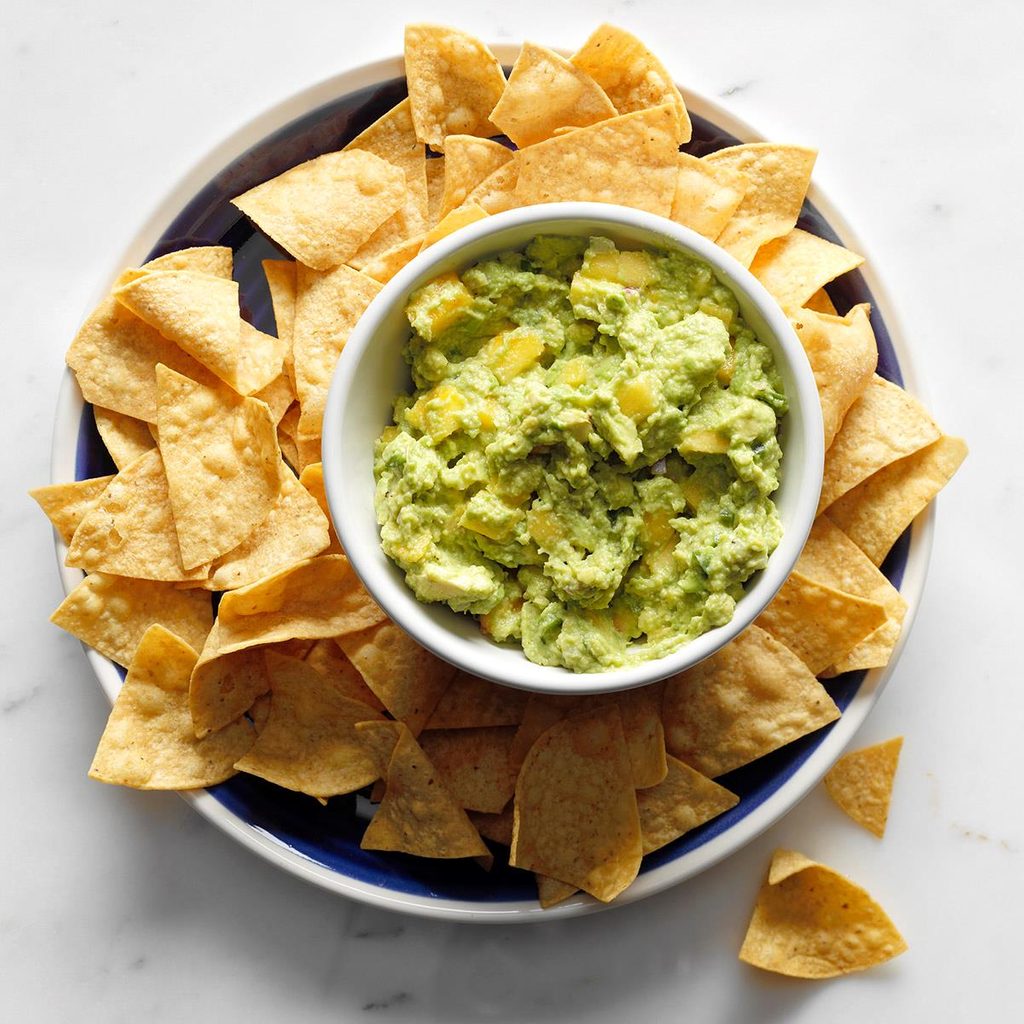Chicken Taco SaladTen minutes of prep are all you need to make this delicious chicken taco salad. The slow cooker does the rest of the work, creating a satisfying and easy-to-make meal even on the busiest of weeknights.
For even more recipes, here are
Amazing Avocado Recipes You Need to Try.
Tomato, Avocado and Grilled Corn SaladWith ripe tomatoes, fresh basil and grilled corn, this bright salad tastes just like summertime! —Angela Spengler, Tampa, Florida
Three-Pepper GuacamoleIf you're serious about guacamole, use a molcajete. The lava stone makes a big difference on the pepper paste and is fun for guests. — Laura Levy, Lyons, Colorado
Cobb Salad WrapsA homemade dressing lightens up these refreshing tortilla wraps. The avocado, bacon, blue cheese and tomato deliver the flavors I enjoy most while keeping me on my healthy eating plan. —Lynne Van Wagenen, Salt Lake City, Utah
Grilled Pork with Avocado SalsaI love the zesty taste of this moist grilled tenderloin. The cumin, avocado and jalapeno give it southwestern flair. It's an easy, elegant way to prepare pork. —Josephine Devereaux Piro, Easton, Pennsylvania
Citrus Avocado SaladThis recipe nicely showcases grapefruit and oranges, which are at their peak around the holidays. Citrus fruits pair well with a sweet dressing. —Sonia Candler, Edmonton, Alberta
Chicken Fajita SaladThis recipe came from Texas, which is famous for its Mexican food. I love to cook, even though it's just for me and my husband now. I invite our grown kids over a lot, and they just love this chicken fajita salad. I'm happy to share it! —Lois Proudfit, Eugene, Oregon
Avocado Fruit Salad with Tangerine VinaigretteOn long summer days when we just want to relax, I make a cool salad with avocado, berries and mint. The tangerine dressing is refreshingly different. —Carole Resnick, Cleveland, Ohio
Veggie TacosFilled with vegetables, chiles and black beans, these vibrant veggie tacos are a delicious and nutritious option for any day of the week.
Mango Avocado Spring RollsAs a fan of mangoes and avocados, I love these wraps. You can substitute tortillas for rice paper wrappers, and lettuce or spinach for sprouts. —Gena Stout, Ravenden, Arkansas
Slow-Cooker Chicken TacosThis slow-cooker chicken tacos recipe is anything but boring or bland. Fresh lime juice, chili powder, salsa and corn give the tender chicken a burst of fresh flavor.
Our fun, simple chicken taco recipe is perfect for a relaxing dinner with friends. If we have any leftover filling, I toss it into a garden-fresh taco salad. —Tracy Gunter, Boise, Idaho
[/rms_recipe]
Orange Shrimp MojoWith jalapeno, orange and avocado, this enticing entree is spicy, tangy and fresh with every bite. The sauce beautifully glazes the shrimp. —Don Thompson, Houston, Ohio
Thai-Style Cobb SaladThis veggie salad is like a mix of Cobb salad and my favorite summer rolls. If you have leftover chicken, toss it in. —Elisabeth Larsen, Pleasant Grove, Utah
No-Fuss Avocado Onion SaladMy mother, Nena, grew up in Cuba and learned many styles of cooking. She had a knack for making something incredibly simple taste amazing. This salad is proof. By itself, the dressing is really tart, but add the avocados and onions and it's the perfect complement. —Marina Castle Kelley, Canyon Country, California
Mom's Sloppy TacosNo matter how hectic the weeknight, there's always time to serve your family a healthy meal with recipes this easy and delicious! —Kami Jones, Avondale, Arizona
California Burger BowlsBurgers are a weekly staple at our house year-round. Skip the fries, chips and bun—you won't need them with these loaded veggie and fruit burgers. To spice up the mayo, add 1/2 tsp. of chipotle powder. —Courtney Stultz, Weir, Kansas
Kale & Bacon Salad with Honey-Horseradish VinaigretteTotally scrumptious and packed with nutrition, this salad was my response to friends who asked how they could incorporate kale into their diets without sacrificing taste. It is also wonderful made with collard or mustard greens, prepared in the same fashion as the kale, or with a mix of spinach & arugula or watercress. —Elizabeth Warren, Oklahoma City, Oklahoma
Avocado Bean DipI love guacamole! But I add beans to boost the amount of fiber in this version. It has a texture similar to hummus and is perfect for dipping chips, pita or veggies. —Raquel Haggard, Edmond, Oklahoma
Shrimp Salad with Cilantro DressingThis pretty salad has such authentic flavor, you'll think you're sitting at a beachside cantina in Acapulco. —Heidi Hall, North St. Paul, Minnesota
Mango Avocado SalsaMango avocado salsa takes your favorite chip dip and elevates it, thanks to the addition of sweet, tropical mango. You can double or quadruple this recipe to feed a crowd.
Southwest Hash with Adobo-Lime CremaAdobo sauce adds so much extra flavor that you won't even miss the smaller amounts of butter and egg yolks in this smoky hash. Here's a tip: Add a splash of white vinegar to the poaching water right before you drop in the eggs. It helps keep them from separating as they cook. —Brooke Keller, Lexington, Kentucky
Tomato & Avocado SandwichesI'm a vegetarian, and this is a tasty, quick and healthy lunch I could eat for every meal. At my house, we call these sandwiches HATS: hummus, avocado, tomato and shallots. These are ingredients I almost always have on hand. —Sarah Jaraha, Moorestown, New Jersey
West Coast Snappy JoesMeet my California-inspired sloppy Joe. Load it up with whatever toppings you like, or pour the filling over noodles. It's incredible on mac and cheese. —Devon Delaney, Westport, Connecticut
Blackened Catfish with Mango Avocado SalsaA delightful and tasty rub makes this quick recipe fantastic. While the fish is sitting to allow the flavors to blend, you can easily assemble the salsa. My family loves this! —Laura Fisher, Westfield, Massachusetts
Avocado Endive Cups with SalsaI jazz up guacamole by serving it atop endive leaves. Add a brilliant red pepper salsa, and you’ve got a standout appetizer. —Gilda Lester, Millsboro, Delaware
Avocado & Garbanzo Bean Quinoa SaladThis delicious quinoa avocado salad is high in protein and holds well in the fridge for a few days. If you make it ahead, add avocados and tomatoes right before serving. —Elizabeth Bennett, Seattle, Washington
Grilled GuacamoleIf you’re a guacamole lover, try this fun grilled version that has a smoky flavor. The veggies tend to darken a bit when heated, so stir it gently to prevent further discoloration. —Lindsay Sprunk, Noblesville, Indiana
Lemon Cranberry Quinoa SaladAs the family cook, I appreciate how easy this is to throw together on a busy weeknight. Plus, this salad never gets boring. One of my favorite variations is to substitute diced fresh mango for the cranberries, cilantro for the parsley, and lime for the lemon juice and zest. —Mary Shenk, DeKalb, Illinois
Caribbean Shrimp & Rice BowlI had a similar rice bowl on vacation and re-created this lighter version at home. It takes me back to the islands every time I make it. Try grilling the shrimp for more beachy flavor. —Lauren Katz, Ashburn, Virginia
Sesame Chicken Slaw SaladI tasted many types of Asian chicken salad in California. When I moved back to Georgia, I wanted more. Here’s a gingery-sweet recipe using wonton strips. —Michelle Mulrain, Evans, Georgia
Fabulous FajitasI've enjoyed cooking since I was a girl growing up in the Southwest. When friends call to ask me for new recipes to try, I suggest these flavorful fajitas. It's wonderful to put the beef in the slow cooker before church and come home to a hot delicious main dish. —Janie Reitz, Rochester, Minnesota
Baby Kale Salad with Avocado-Lime DressingWe pull a bunch of ingredients from our garden when we make this baby kale salad with zucchini and sweet onion. The yogurt dressing layers on big lime flavor. —Suzanna Esther, State College, Pennsylvania
Homemade GuacamoleI always judge a Tex-Mex restaurant by its guacamole. And although it's simple to prepare, it can go wrong oh, so easily. I've spent many years perfecting mine, to the point where I think it's better than most restaurants. —Joan Hallford, North Richland Hills, Texas
Shrimp Avocado SaladShrimp avocado salad mixes tender shellfish with fresh vegetables for a cool, protein-filled lunch or easy light dinner.
Pickled Pepperoncini Deviled EggsIt's hard to resist these adorable deviled trees on our buffet table. The avocado filling has pepperoncini and cilantro for extra zip. —Carmell Childs, Clawson, Utah
Skinny Cobb SaladThis skinny version of Cobb salad has all the taste and creaminess with half the fat and calories. You can skip the coleslaw mix and use all lettuce, but I like the crunch you get with cabbage. —Taylor Kiser, Brandon, Florida
California RollMaking your own California sushi roll is surprisingly easy. You'll need a bamboo mat, sushi rice and nori sheets to get started, and with a bit of practice, you'll be a pro in no time.
Peachy Jalapeno GuacamoleFresh jalapenos and summer-ripe peaches give this creamy guacamole so much flavor. It's got a little kick, but I love that it's not so spicy it burns off my taste buds! —Colleen Delawder, Herndon, Virginia























